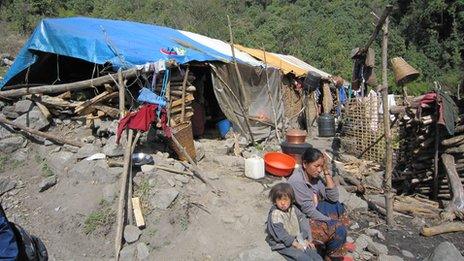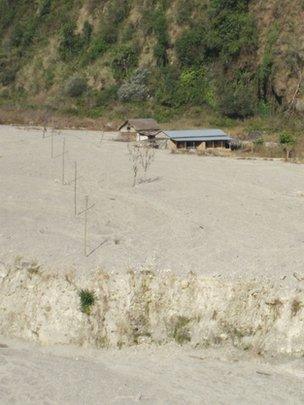Nepal floods change river course and threaten tourism
- Published

The shifting course of the river has created new cliffs that threaten a number of buildings
A major tourism destination in western Nepal faces increased risk of natural disasters following a devastating flood last year, experts have warned.
They say the sudden flood on the Seti river, which killed more than 60 people, has brought changes in the course and flow-pattern of the river.
These changes are now threatening human settlements in and around Nepal's second-largest city Pokhara.
The changes may set the stage for serious effects on tourism in the area.
A scenic city and a gateway to Nepal's most-trekked region, Pokhara is located close to towering Himalayan mountains like Annapurna, Dhaulagiri and Machhapuchhre.
During a recent visit by the BBC to the foothills of the Annapurna range, where the Seti river originates, several locals' houses and tourist restaurants upstream of Pokhara already appeared to be at risk.
In the northern outskirts of Pokhara, at least half a dozen houses have been swept away in subsequent floods because of the changes in the river's course after the sudden flooding, which occurred one year ago on Sunday.
'Eaten up'
Geographers and hydrologists say deposition of a great deal of mud, pebbles, sand and boulders by the flood at several sections of the waterway is responsible for the changed river-course.
Some houses have been deserted because the edges they stand on have been collapsing due to erosion; a few metres away, a highway that connects with a newly built road reaching the Tibet border is threatened.
"With the river having changed its course after last year's flood, several sections of the riverbanks that people thought were safe for human settlements earlier have now been eaten up by the river," said engineer Dhurbaraj Poudel, who heads the Nepali government's water-induced disaster management office in Pokhara.
Although the reason for the flood is still debated, some believe it was an avalanche-induced rock failure on the flanks of the Annapurna mountain, which in turn hit a temporary mud-dam 2,000 metres below.
They think the collapse of the dam formed by previous landslides caused the impounded water to burst out.
A number of villages and markets were wiped out as floodwaters hurtled towards Pokhara, sweeping away people and livestock.

Families displaced by the floods are still living in makeshift housing
The debris deposited by the flood is as high as 20 metres at places.
But people are now more concerned about monsoon-driven floods, rather than the kind of sudden flooding last year.
"That unusual flood set a dangerous stage like this," said Thakur Prasad Wagle, a local leader.
"These people had never imagined that the river that flowed on the other side of the basin would come to their doorstep one day."
Another local resident said she moves to a different house during monsoon and comes back when the rainy season is over.
"If I don't do that, any one of the nights during monsoon can sweep us away - because we did see water coming like that last rainy season."
Tectonic tussle
Prof Krishna KC, who heads the geography department at the Prithvi Narayan Campus in Pokhara, agreed about the risks to settlements, but thinks that the main tourist centre in Pokhara does not face immediate threat because it is relatively far from the waterway.
"But if there is a really huge flood, then you never know, and I don't want to imagine that now."
Formation of this valley itself is linked to gravel deposition following outbursts of huge glacial lakes from this section of the Himalayas thousands of years ago.

The floods swept away some buildings and brought silt that half-buried those that remain
The Himalayas are fragile mountains formed from the tussle of tectonic plates that make the region seismically active.
While earthquakes have often been blamed for rock failures and landslides on mountain slopes, scientists also point at global temperature rises for rapid thawing of snowfields and glacial melt that can disturb the flow of snow-fed rivers.
The Seti river brings down heavy sediment of limestone and has formed several gorges in and around Pokhara, making it even more vulnerable.
Mr Poudel said even the heart of Pokhara faces the threat in the wake of the changes in the river's waterway.
"There is at least one channel that flows out of the Seti river into the Phewa Lake (one of the prime attractions of Pokhara) and in case of a big flood that could invite disaster for the centre of the touristic spot."
The Phewa lake adjoins the main tourism area housing mainly hotels and restaurants.
Meanwhile, tourism activities including paragliding, zip-wire flying, restaurants and lodges are spreading in the outer areas of Pokhara as well.
Three Ukrainians were swept to death by the unusual flood last year when they were at a hot water spring along the Seti river some 20 kilometres north of Pokhara.
Tourism entrepreneur Basu Tripathy said the threat for their industry loomed large.
"We entrepreneurs along with the civil society have been requesting the government to take serious initiative in time."
But Poudel of the water-induced disaster management centre said he has been given $3,500 only despite his repeated request for a bigger budget.
"With that money, all we can do is wait for the disaster with gabion and wire only."
- Published5 May 2012
- Published6 May 2012